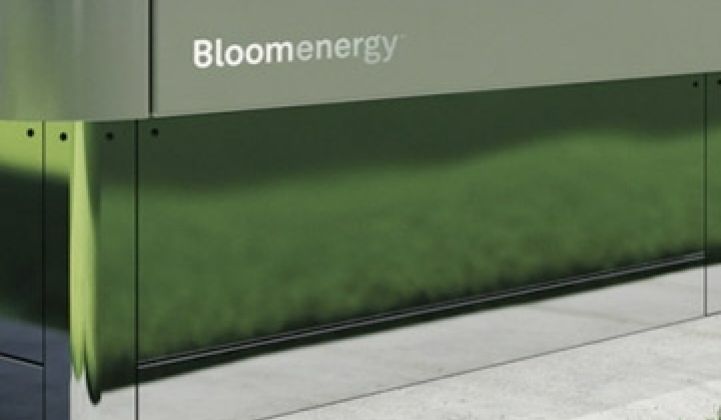Bloom Energy held its big coming out party last night on 60 Minutes. And while founder K.R. Sridhar went over the potential and promise of the company's Bloom boxes, he got a little vague when it came to what makes it tick.
The system converts methane or other hydrocarbons into electricity by mixing it with oxygen and then passing the gas mixture through ceramic plates coated with proprietary inks at high temperatures. What are the inks made of? He wouldn't say. (You can see me in the video too, Mom.)
A U.S. patent filed in 2006 and granted to Bloom in 2009, however, seems to indicate yttria stabilized zirconia. Do I know what that is? No. But the invention described in the patent seems to describe the box that Bloom wants to make. The patent application also calls for electrodes comprised of platinum family metals. Platinum, one of the world's more expensive metals, has been the bane of fuel cell makers. It simply raises the price too high. Platinum is also an element in catalytic converters. Start-up Nanostellar has come up with powders that help get around the problem for the car industry. Some of Nanostellar's powders contain gold, but the powders are cheaper than standard platinum, CEO Pankaj Dhingra tells us.
Sridhar said Bloom is not using platinum, but clearly there seem to be alternatives floating around.
We may find out more on Wednesday when Bloom holds it coming out party. In the meantime, here is the relevant part of the patent. It is not Bloom's only patent and may not be the basis of a lot of the technology inside the Bloom box, but it's something:
"The SORFC contains an anode electrode, an electrolyte and a cathode electrode. Anode electrode 11 is preferably a porous electrode comprising perovskites, metals and/or cermets. Preferably, the anode electrode comprises a perovskite material. Cathode electrode 12 is also preferably a porous electrode comprising platinum or platinum family metals. Preferably, the cathode electrode comprises platinum. Solid oxide electrolyte 13 is sheet of ceramic material, such as yttria stabilized zirconia. Electrodes 11 and 12 are attached to electrolyte 13. An anode gas chamber 14 is formed between the electrolyte 13 and an anode side interconnect (not shown for simplicity). A cathode gas chamber 15 is formed between the electrolyte 13 and a cathode side interconnect (also not shown for simplicity)."
One of the more interesting things that could come out Wednesday is whether Bloom is serious about the regenerative reaction of its box. On 60 Minutes, Bloom talked about producing electricity and heat from methane or other gases. Panasonic, Ceres Power and ClearEdge Power have developed fuel cells that can do this and Panasonic and ClearEdge already sell such fuel cells. They aren't as large as Bloom's fuel cells and may produce more heat and less electricity than Bloom's, but they roughly do the same thing. (Ceres will produce a cell that produces 50 percent electricity and 50 percent heat--a fairly impressive ratio, particularly because electricity has a higher value.) And all of these fuel cells can provide energy in a more efficient manner than the grid, so even if they emit carbon dioxide--and the ones from Panasonic, ClearEdge and Ceres do--you get a lot more power for the amount of greenhouse gases generated than you ordinarily would.
UTC Power, division of conglomerate United Technologies, makes fuel cells too and nearly all of the other industrialists have projects underway.
But Bloom also talks about a reverse reaction in its patents. In the reverse reaction, the waste heat and carbon dioxide generated in the methane-to-power reaction is sent back through the fuel cell and charged with electricity. This allows the box to generate a methane-like fuel and oxygen. To perform this reaction, the carbon dioxide is first liquefied with the heat from the first reaction and the electricity also comes from the first reaction. You also may need ruthenium. More from the patent:
"In operation, the underwater vehicle leaves port with an oxygen storage vessel about full, a hydrocarbon storage vessel partially full and a carbon dioxide storage vessel about empty. The primary power generator provides power to the SORFC in the electrolysis mode to generate and store oxygen and hydrocarbon fuel. Then, the stored oxygen and hydrocarbon fuel are used to generate power and to generate and store carbon dioxide when the SORFC operates in the fuel cell mode. The underwater vehicle returns to port with the oxygen storage vessel about full, the hydrocarbon storage vessel about full and the carbon dioxide storage vessel about full."
Cue "In the Navy."
If this works, this would mean that the Bloom box could produce power on demand with almost no emissions. However, transforming carbon dioxide into fuels isn't easy and neither is conserving that energy from the first reaction to run the second one. The Department of Energy is funding several cutting-edge start-ups to see if they can come up with ways to do that. Energy for the reaction could be helped by solar panels. Perhaps that is what Sridhar meant when he talked about the box working with solar panels.



